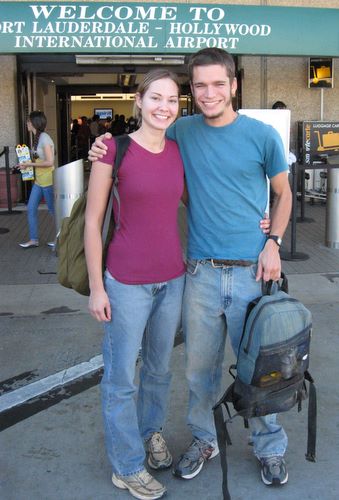
We were so clean then...
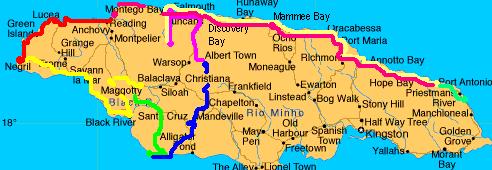
I had been trying for some time to find a cheap airfare to anywhere in the month of December but had met with little success. I was considering destinations the world over, from Addis Ababa and Istanbul to Quito and Lima. With each passing day, the prices only became more and more exorbitant, until I was actually entertaining the possibility of spending my two weeks off in Frankfurt or any one of a number of Scandinavian cities which, strangely enough, were all offering dirt cheap fares. As the last shreds of hope were slipping away, I discovered a single budget-friendly fare in SpiritAir's weekly sale; it was settled - I would be going to Jamaica, and naturally I would be dragging my unsuspecting girlfriend Andie along for the ride.
It was some weeks after I had bought my tickets that news of my plans seeped out to my family. Now, I had long been the subject of some degree of criticism from certain family members for my odd excursions, but my latest choice in travel plans drew an unusually venomous response. My uncle Piet seemed convinced I'd be better off hopping on a camel train to Kabul, my cousin Piet suddenly erupted with every manner of sordid tale from the terrifying week he and his friends had spent on the island rooming with drug dealers, and my aunt's parents could only shake their heads in dismay. The overwhelming consensus was that Andie and I should immediately forfeit our tickets and occupy our extra weeks with other pursuits. We summarily ignored all of these comments and made a b-line for Fort Lauderdale shortly after the last of the presents had been opened and the last of the mashed potatoes had been polished off.
SpiritAir, like many who do business in the Caribbean, tends to run on a more relaxed schedule, and it was not until half an hour after our scheduled departure that the plane finally moseyed up to the gate. While we were still on the runway, we were informed that Cuban airspace had been temporarily sealed off to international flights; this was resolved in the next 10 minutes, and we were on the ground in Montego Bay within an hour and a half. An inquisitive customs official seemed at once intrigued and troubled by our method of travel and inquired as to where I had attempted it before, and confirmed with Andie that she "enjoyed the enterprise." We were let loose on the mean streets of Jamaica's second largest city in the last remnants of dusk.
Someone claimed that an unmarked Corolla driving through the airport lot was in fact a shared taxi, so we hopped in, and sure enough, it took us and three other random people to the center of the town for 75 cents each. We had left the glitzy, overpriced tourist resorts behind to seek out a $20/night guesthouse in center city. This turned out to be a semi-fenced shack on a main street with random locals, joints in hand, marching down the halls at random intervals. There seemed to be little separating us from the rabble beyond and we gathered with a smattering of other western tourists in a futile attempt to find strength in numbers. Before too long we fled to our room to seek the comfort only a deadbolt and chain can provide. In the street outside, one youth pulled up his pimped-out ride and started blasting out tunes on his bass-rich stereo system; this would continue until roughly two in the morning. To some degree, the angry notes of Jamaica's latest rap hits provided some relief from other noises of a more disturbing nature coming from the surrounding rooms; it seemed that in addition to being a guesthouse for foreigners, this particular establishment also allowed locals to pay for rooms by the hour - we got our fan (temperatures in the Jamaican winter drop to around 95 degrees overnight and a fan is absolutely essential) from a guest who was checking out at 10PM. Andie decided that she would push our dresser up against the door as an added measure of security; this was all well and good until about 2AM when this arrangement made reaching the shared toilet down the hall prohibitively difficult, and so, for the first time above ground, I was forced to sacrifice one of my disposable water bottles to resolve the crisis.

We were so clean then...

View from our hotel patio
We wandered up to the tourist district where miles of souvenir shops, overpriced pirate-themed bars, towering resorts, and go-cart tracks slumbered while tourist and tout alike slept off an alcohol- and/or ganja-induced stupor. Back in the bustling downtown, we noticed a number of locals congregating at the craft market and soon found a nondescript breakfast counter where we ordered the two dishes on offer. A typical Jamaican breakfast consists not of cornflakes, but of an exceptionally salty fish, mixed with ackee fruit or vegetables, and accompanied by a variety of tubers and dumplings. The starches are exceptionally bland while the main dish has a flavor which is something akin to a dirty sock immersed in salt water. By combining these two opposing forces in exactly the right quantities with just the right amount of hot sauce, one can enjoy a very palatable meal, but the subtleties of this combination were lost on us in our first attempt at breakfast and the result was something wholly inedible.
Kingston is the cultural center of the nation and Montego Bay is not. The town's one museum consists of a single room that was likely put together for an eagle scout project. A walking tour of the city includes about 7 different sights which are all trivial, ruined, or nonexistent. Indeed, the country's "tourist epicenter" seems to have virtually nothing to offer in the way of attractions outside of a few well-manicured white sand beaches that each charge about five bucks to enter.
We soon found ourselves heading to the transportation hub of the city. Upon arriving here, we were instantly assaulted by a large crowd of touts, each pulling us one way or another to try to get us to ride in his van. We were at first puzzled because all seats in the vans to which we were tugged appeared to be full, but we would soon be all too aware of one of the central tenets of Jamaica's route taxi system: "there is always room for one more", and through a bit of inductive reasoning, there is always room for two more.
The shared taxi system is easily the most ingenious form of public transport I've encountered thus far. The car leaves the instant enough people arrive (this was typically on the order of 30 seconds from the time we arrived at the station) and the driver then barrels down the road as fast as he possibly can so as to maximize the number of runs he can do. A winding mountain road with an 80kph speed limit, which would only allow a normal bus to do 50 or 60, could be negotiated by a knowledgeable route taxi driver at 120kph. Since the taxis run the same route a dozen times a day, they know the location and depth of every pothole and the curvature of every turn, and know exactly how fast they can go for every meter of the road. The result is an amazing rollercoaster ride where you can be reasonably confident that you will likely not end up flying through the windshield (for comfort, all of the backseat seatbelts have been removed).
The choice vehicle for lower capacity taxis is the Toyota Corolla; for the many years I've driven a Corolla, I've always assumed 4 people to be a full load, and 5 people to be just plain uncomfortable, but the route taxi drivers won't even leave the station until they have 4 people crammed into the back seat. And since prices are by number of persons and not by weight, a skinny kid and a corpulent adult are the same in the eyes of the driver. Andie related a story to me of how on one particularly lengthy ride, she had been nearly suffocated by an oversized boob that flowed unchecked from an unusually large adjacent passenger.
We stopped in the market town of Lucea for a bit before hopping on the connecting bus. Produce from around the region was sold in colorful piles in little wooden carrels and it was all too tempting to grab a giant yam or jackfruit to take as a souvenir, but in the end I was forced to admit I didn't know the first thing about these tropical foods or how to prepare them. We quickly gave up on self-catering and went to a local I-tal "rastaraunt." Rastafarians make up about 20% of the population and have established special restaurants that use no meat, salt, or other "unhealthy" ingredients in their meals. Our first foray into this new cuisine proved disappointing, as the dish lacked even the slightest hint of flavoring, and led us to question whether a bit of salt from time to time were really such a terrible thing after all.
The sleepy town of Negril was a far cry from what we'd encountered up until then. We passed unhassled through a market packed with crafts created on site such as meter-high wooden giraffes and macramé bikinis to arrive at a laid-back beach with perfectly clear, azure waters. The town's only listed $20 guesthouse was right across the street and consisted of a number of small wooden shacks, a number of outhouses (with complementary toilet paper!), and a well-stocked kitchen.
The lighthouse on the country's westernmost point was about 6km south of town, and we began the long hike down the winding, shoulderless road with about 3 hours of daylight left. The first notable attraction on the route was a hotel known as Blue Cave Castle. We were informed by the gate attendant that all rooms were booked a year in advance (I suspect this was because of my stinky shoes) but we were free to look around. The castle was a brightly painted concrete structure that had been shamelessly adorned with every manner of fake medieval artifact (i.e. treasure chest, spray-painted cow skull, floor tiles with printed stonework). The parapets offered excellent views of the cave-riddled cliffs that stretched for miles along the West End. Stairs led from the main floor down to a huge sea cave filled with bright blue water and well-preserved fossils.
Continuing a little further down the road, Andie spotted a small, dark, cobwebbed cave opening behind some barbed wire on the side of the road. We asked the kids at the neighboring drink stand about it and they replied that they had always been too scared to venture down into it but a crazy uncle had attempted it once. Andie, undeterred by this news, resolved to explore it; I certainly admired her spunk, but without headlamps, helmets, or local knowledge, I was inclined to look elsewhere for my first descent into Jamaican caving.
As luck would have it, a bar just down the street offered cliff diving and sea cave snorkeling. A few giant catamarans sat right off the cliff face, delivering hordes of tourists from the all-inclusive resorts to try their hand at the 20-meter drop. Neither of us was particularly interested in falling from that height so we just took the stairs down to swim in the cave below; Andie described her swim through the subterranean passage as the "best thing she'd ever done." Another bar a little further down had shorter cliffs but better publicity than the first and probably held about 2/3rds of the town's tourist population.
On the subject of tourists, we had begun to notice an interesting trend in our travels on the island: though we had failed to pass ourselves off as black Jamaicans, we did come across as a very ambiguous brand of foreigner. Several people simply refused that we were Americans, insisting that we were instead Latinos or Italians or a people belonging to some lesser known patch of southeastern Europe. It was never really clear whether this was due to our well-tanned skin or the fact that we were the only tourists around wearing long pants in the 90 degree weather, but the touts that constantly harassed the other white people largely left us alone. Many stopped to ask if we were Peace Corps or had some other business on the island.
We finally reached the lighthouse with only half an hour of daylight remaining; the tower was closed but we grabbed a spot on a scenic limestone outcropping to sit and watch the sunset. Back out at the road, we hopped in a route taxi and returned to town. Reluctant to pay tourist prices for food, we grabbed some rice and beans at the market and made use of the hostel kitchen. Our plans to watch a movie from the guesthouse's extensive VHS library were thwarted by the fact that there was only one outlet to be shared between the TV and VCR; this just seemed like poor design.
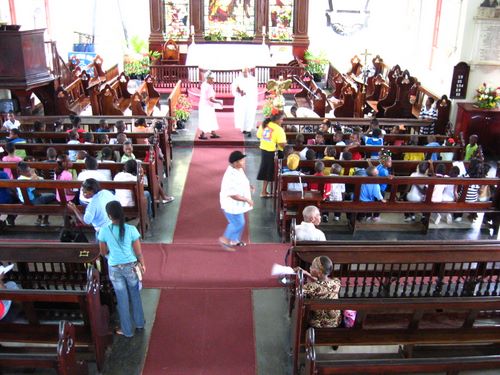
Spying on a children's liturgy
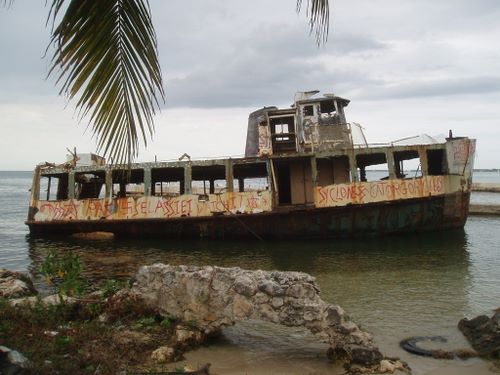
One of many long abandoned things

Not just every church has a steal drum band!
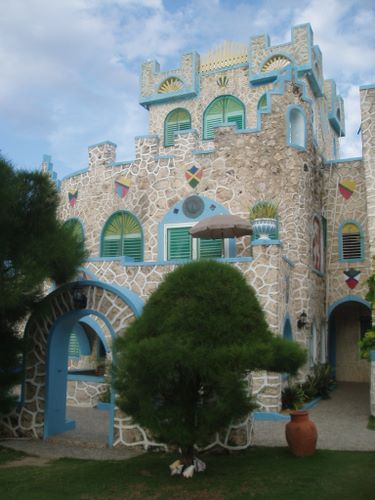
Maybe we'll stay here next trip
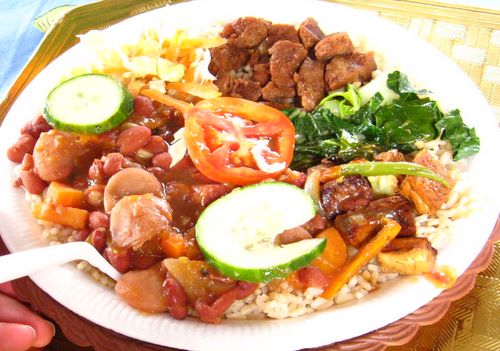
I-tal food (sans meat, salt, and taste)
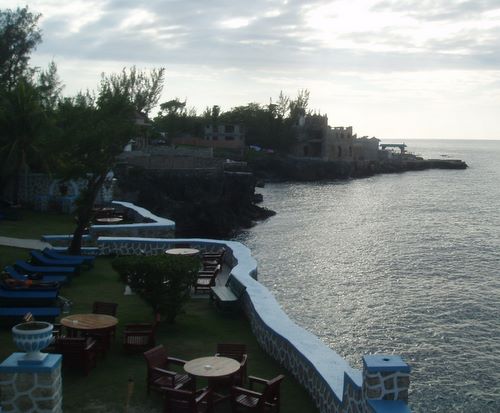
View from the castle

The only road into the great morass
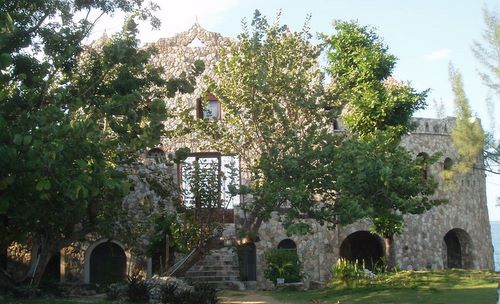
An abandoned resort perhaps?
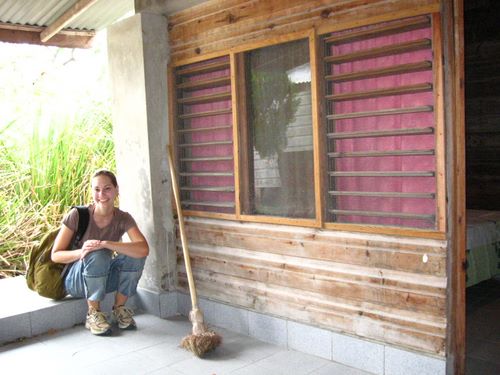
Our hut
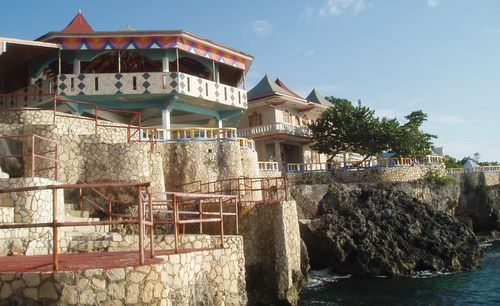
The cliffs of Negril
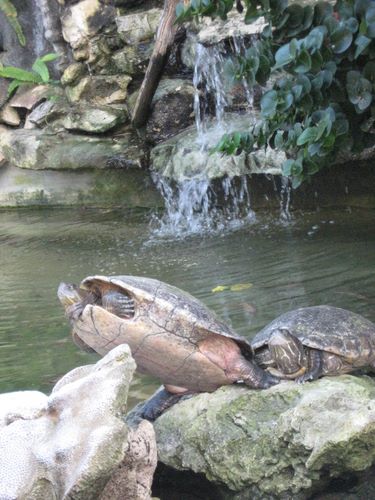
An expertly balanced turtle
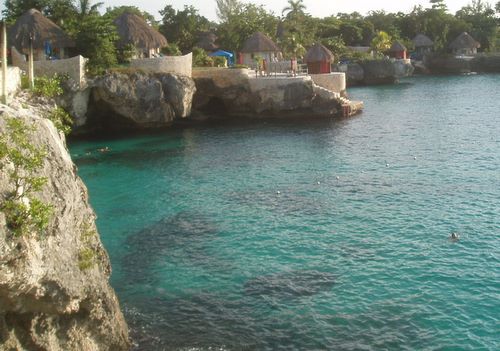
Snorkeling and cliff diving - a potentially lethal combination
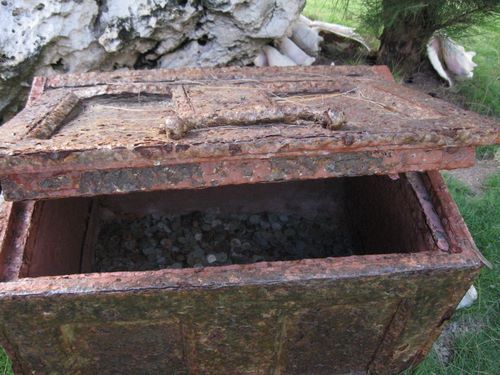
A treasure chest
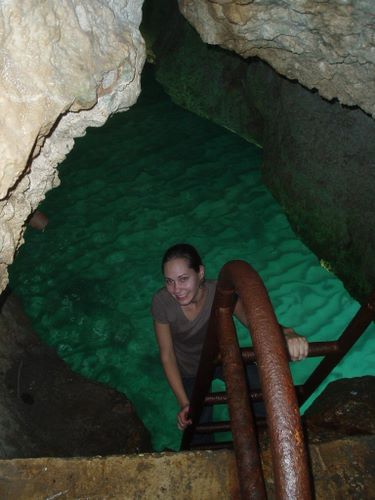
Andie ascending from the depths
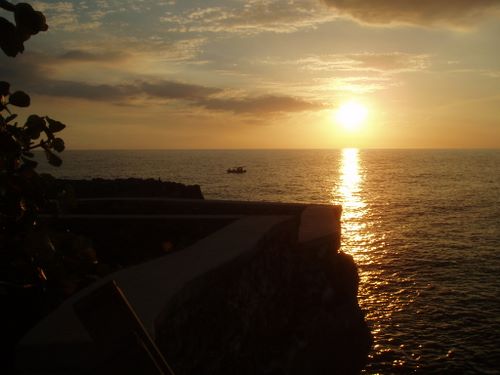
Sunset over Negril's West End
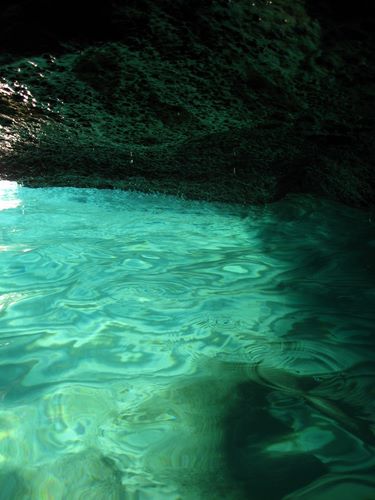
In a cave
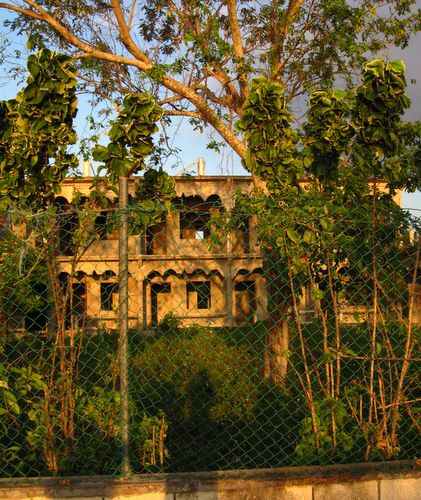
Abandoned dream #463
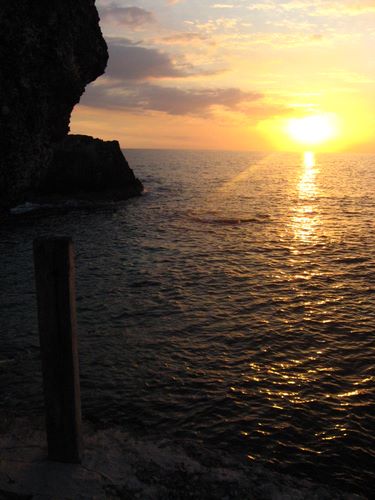
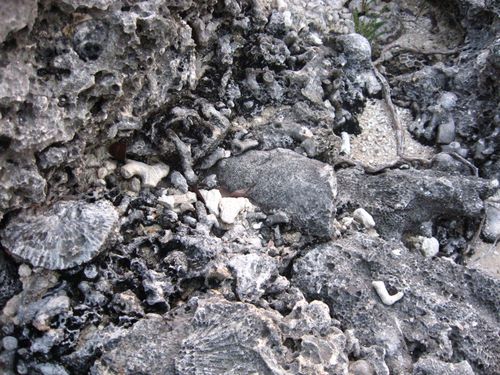
Ancient reef fossils - the whole island is covered in them!
Having explored extremities of the absurdly expansive community of Negril, the only option left to us was to head east into the Great Morass; this was an imposing expanse of swamp emanating out from the Negril River. We hired a boat to take as to the furthest navigable point. For half an hour, we followed the river through mangroves and tropical bush before reaching a fork where both the left and the right narrowed significantly and began to gain in elevation toward Sheffield and Springfield respectively. On the return trip, we stopped at the semi-abandoned Royal Palm Reserve; here the guides took us to see a fenced crocodile pit where a 12-footer sat baking in the sun with its mouth agape. From our preliminary inspection, we concluded that it was dead. Our guide would not stand for this misconception and began to chuck rocks at the creature to prove its vitality. The third or fourth stone hit the beast square in the nose and it recoiled fiercely before resuming its previous motionless state.
Following this close encounter, we returned to town; Andie and I admired the scenery while our guide and his friend made jokes about us in Patois. The Jamaican pidgin language, despite being derived in part from our own, bears exactly zero resemblance to English and can be understood by a native English speaker about as well as he might understand Dutch.
We returned to the cliff divers' café equipped with our guesthouse's complementary snorkel gear and explored the submerged caves as well as the surrounding reefs while trying our best to avoid falling divers and getting smashed into jagged rocks by the waves. One of the professional divers free climbed up the coral-laced cliff and did a handstand on a 30-meter ledge; I told Andie to try this as I thought it would make an excellent Facebook profile picture, but she opted to stay in the water and swim around a bit more.
Heading back toward town, we came to the realization that we could walk into any of the resorts and bars along the route and use their facilities free of charge. At one, we found a series of caves housing the remains of in-cave bars and plenty of opportunities for superb snorkeling. At another we found an awesome view of the cliffs and the setting sun, as well as a bathroom at exactly the moment I needed it to address a sudden and overpowering reaction to the callaloo patty (a fast food item made of a spinach-like vegetable wrapped in a flaky crust) I'd had for lunch.
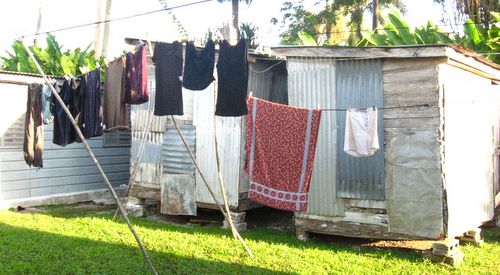
The manager's suite at our hotel
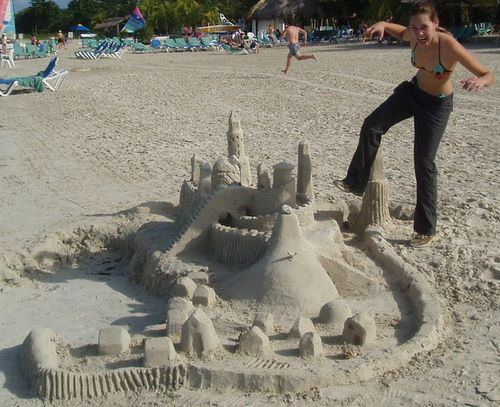
Andiezilla!
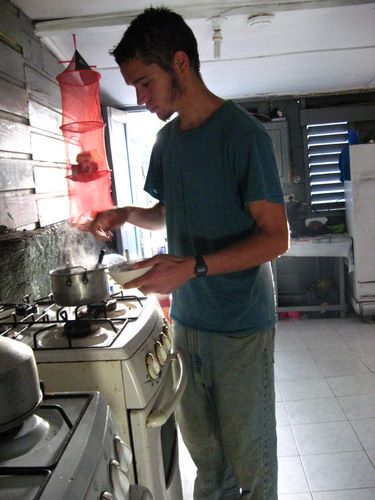
Cooking up something tasty

Every quiet, remote beach needs water park
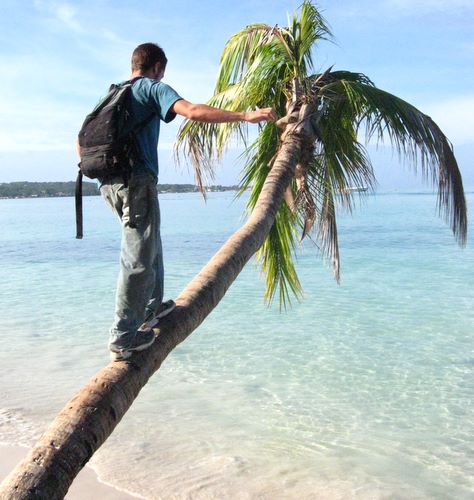
Not nearly as interesting as when I fell in two seconds later
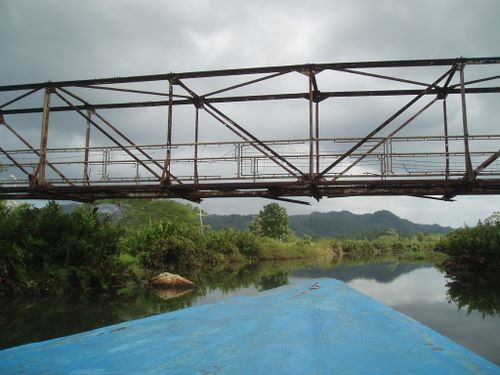
This bridge is one of the region's oldest structures - it's nearly 30 years old!

Colorful clothes line
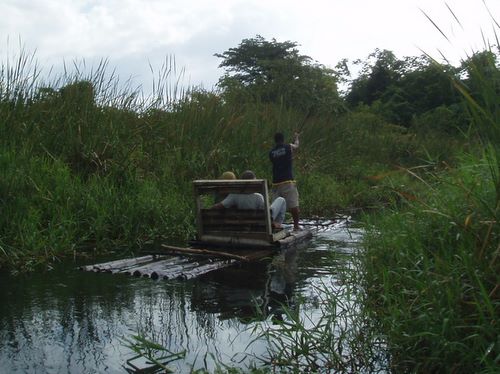
Silly tourists - our powerboat was so much faster!
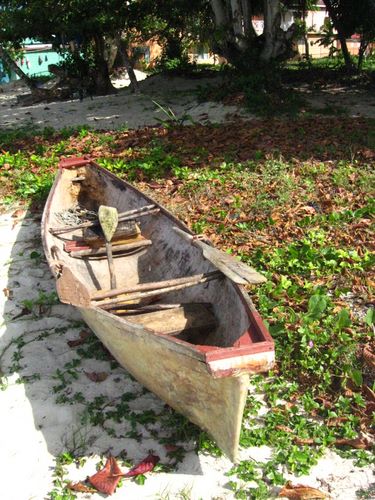
Typical fishing vessel
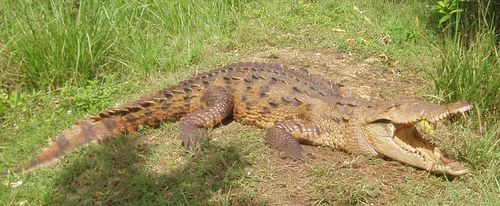
We just happened upon this fellow in the middle of the morass
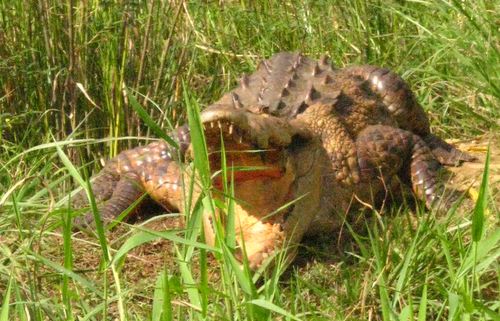
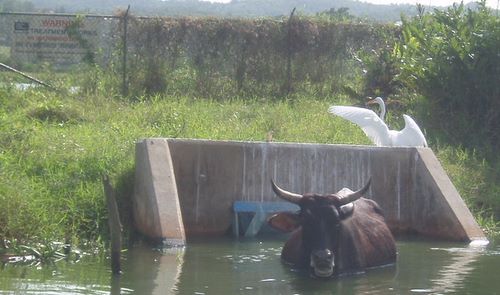
Wallowing in the warm effluent of the wastewater plant

This woman is using a surfboard to fish

Professional cliff diver
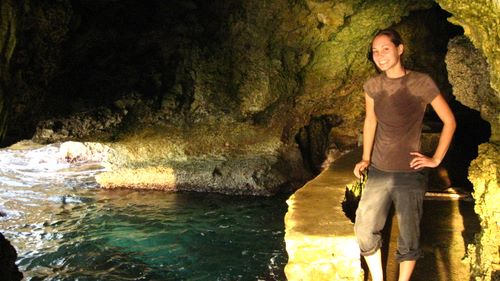
Hanging out at a sea cave bar
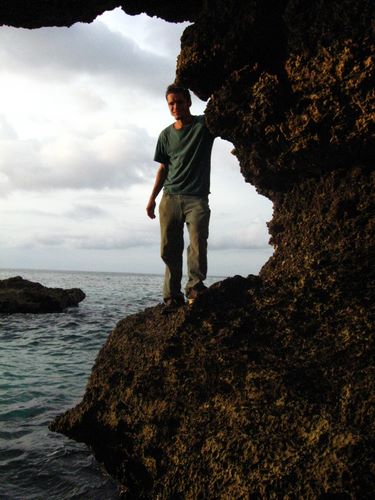
Right before I deep water soloed the overhanging cliff...
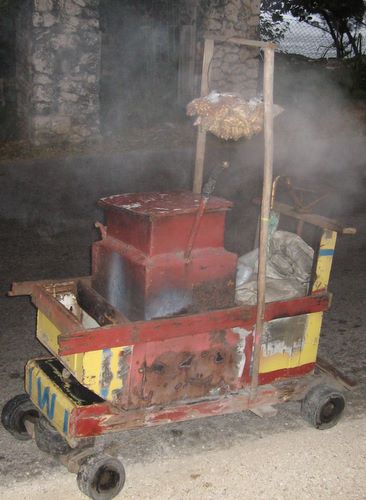
No idea what this thing is cooking
We grabbed a route taxi to Savanna-la-Mar which was a bustling market center every other day of the week; today the streets were deserted save for a few dozen militant taxi drivers who were deadset on taking us to wherever we were going. We eventually found a driver willing to take us to Black River for a reasonable fare and we arrived in time for lunch at the town's one open restaurant. Finding little to do here, we pressed on to YS Falls, rumored by some to be the finest in all Jamaica. For a ridiculous fee of $13 per person, we got admission and a tractor ride back to the waterfall. The park was way too developed for its own good, with boardwalks and stairs leading to each of the cascades, and lifeguards stationed at each swimming hole, but there were still plenty of opportunities to shimmy along the edge of a waterfall or sit under one, and even a few spots where we could crawl into a cave beneath a fall. Two rope swings allowed visitors to hurl themselves into the pools, though one was permanently occupied by an Asian baby and his proud father. For $30 above and beyond the price of admission, you could ride a zipline over the falls; we were far too cheap to attempt this.
The next stop on our journey was the small town of Maggotty (I think it must have been the name that drew us there). For whatever reason, there were no taxis running the 10km route and the cheapest charter offer we got was 21 bucks, so we opted to hoof it. This turned out to be a scenic hike over several high mountains with virtually no traffic (not a single car passed for the first 3 miles). On the mountaintop, a poor village was filled with colorful huts, meandering goats and donkeys, and an enthralling soccer game that the whole town had turned out to see. We reached the outskirts of Maggotty just as it was getting dark. We mentioned a guesthouse in our guidebook to someone at a roadside grocery store and she explained that she worked there and called her boss. He came to meet us as we entered the town and directed us to a dark, seemingly abandoned amusement park. We were guided to the inner recesses of the park and shown a caged shack with a number of bunk beds, two bedrooms, and two bathrooms. For the price of $21, we could sleep here and take the paddle boats or kayaks out on the park's ponds at any time during the night. The only other resident was a potentially retarded groundskeeper who assured us he would keep us safe through the night.
All the restaurants in town were closed, so the groundskeeper escorted us to the supermarket where we secured a loaf of bread, a block of cheese, and a bottle of orange soda (the kitchen facilities at our "guesthouse" were "locked for the evening"). As we dined on our gourmet feast and reread the book's description of the place, we realized that our cage bore little resemblance to an "18th century red-roofed great house with five bedrooms and lounge" and we began to feel that something might be amiss. Our chances to sleep were diminished to some degree by a death-reggae concert being held until 2am just on the other side of the river, but besides that, our stay in this decrepit, third-world Disney was a pleasant one.

Not the busiest of days for the Black River market
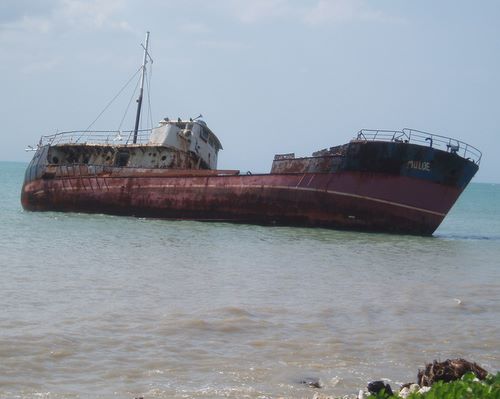
No need to take that ship to a junkyard, just make it into a photo-op
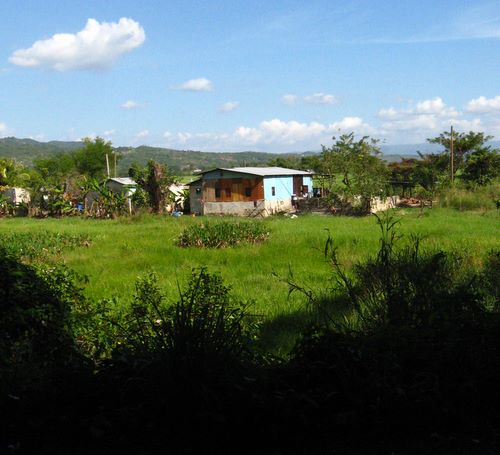
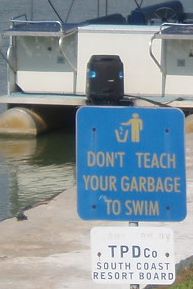
Jamaica has some issues with litter

Riding to the waterfall in style
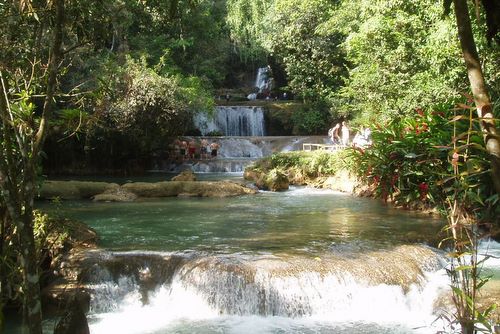
YS Falls
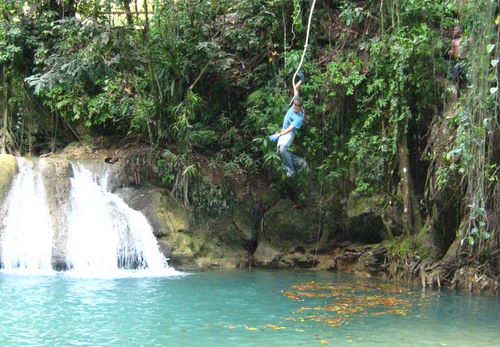
Rope swing
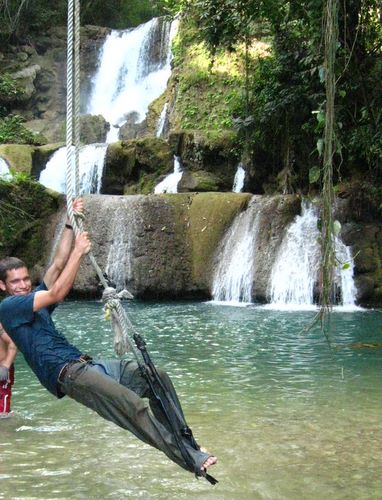
Another rope swing
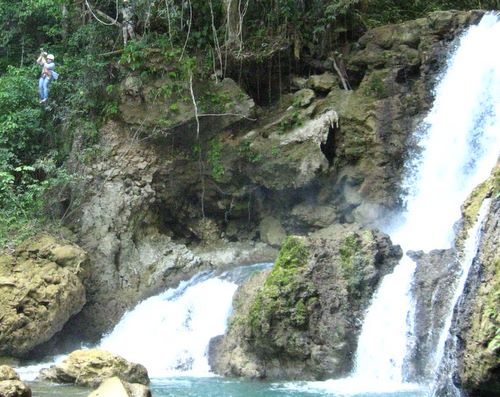

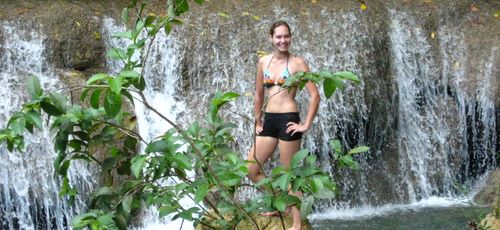
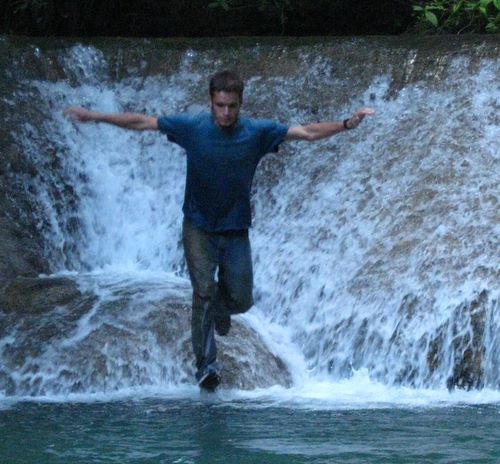
Me doing my walking on water trick
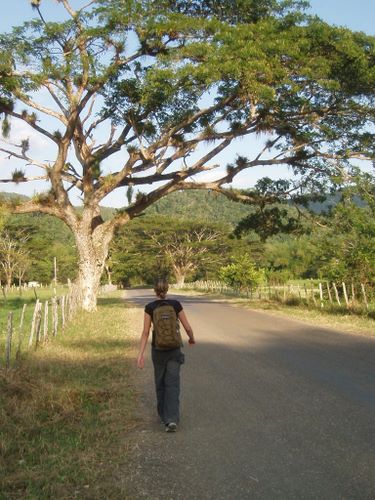
Hiking into the unknown

I think Andie was going for some cool color thing
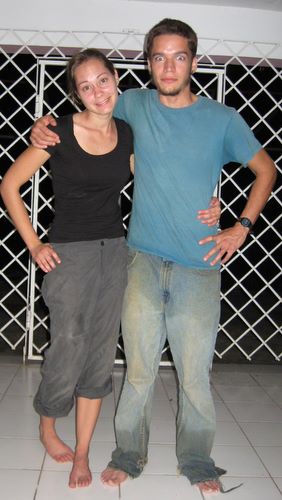
Hanging out in our cage
We walked around the small town in search of some sort of breakfast but found there was really nothing to the place beyond a few stray goats and a pile of burning tires. We stopped at the police station to inquire about the series of 28 "roaring cascades" of the Black River Gorge which our book had raved about, but none of the officers had ever heard of the gorge or its falls; they also informed us that the guesthouse where we had intended to stay the night before had closed its doors some time ago. We returned to the town's main (and only) intersection and hopped in a taxi to go to Santa Cruz; we hopped out so that a group of men could push start it, got back in again, and then were on our way.
Arriving at the region's commercial hub, we grabbed a delicious breakfast of ackee, saltfish and stewed chicken at a local shop. Ackee is a fascinating fruit that has roughly the consistency of scrambled eggs and is poisonous if consumed before it's ripe; I gather mine was ripe. We then set about getting to Treasure Beach, an out-of-the-way destination for those travelers fed up with the crass commercialism of Negril. The first cab took us to the crisp mountain town of Malvern. Since the region's schools were out of session, no one was going to the beach on this particular day and we sat for a good hour before a driver took pity on us and gave us a free ride to the next junction. Here we eventually got a ride to Southfield and from there walked the 3km to Lovers Leap.
A quick note on dining in Jamaica: restaurants often have extensive menus featuring a variety of dishes included such exotic choices as "cow foot" and "chicken back", but without exception, at any given time, 70-90% of the dishes on the menu are not available to be ordered. The following represents a complete list of all the dishes ever offered in the 15 or so restaurants in which we dined over the course of our trip: curry goat, stewed chicken, stewed beef, curry chicken, stewed fish, saltfish, mackerel, and vegetable. We found no evidence to suggest that it was ever possible to get any of the other items on the menu. If the foods you like are not on this list, and you cannot adapt to these or to the ubiquitous beef patty, do not go to Jamaica - you will starve.
Lovers Leap is a lovely spot that commemorates the suicidal plunge of two slaves who stepped off the 500m cliff and fell to the waves and rocks below. The entry fee was $1.50 but was waived with the purchase of a meal - since we were ready to eat anyway we went for the meal option, but what we didn't anticipate was that they would tack on an additional $8 in charges beyond the price quoted on the menu. Following this absurdly expensive lunch, we set about finding the trail to the beach and caves half a kilometer below. After 20 minutes of hiking down the treacherous trail, we realized that we had little chance of making the return trip by nightfall, and thus we would either have to abandon the pursuit or set up camp on the beach below. With only a liter of water and a bag of cookies between us, the latter idea seemed a little crazy even by my standards, so we opted to continue on to our original destination. We caught a route taxi where we shared the backseat with two very large women (an 80lb girl sat in the front seat) and sped to the quiet seaside town.
The collection of four placid coves that awaited us at Treasure Beach housed deserted fishing beaches and was divided by impressive rocky headlands; it was truly a Jamaica from another age. No taxis honked as they cruised along the main strip and no hustlers followed you along the beach selling Rastafarian hats and illicit drugs. The beachside cottages all sat with their doors flung wide open and white women walked by themselves to the farthest reach of the sands with no qualms about being caught outside after dark.
We had not known it at the time of planning (a few hours prior to arriving there), but the town of Treasure Beach was renowned the island over for a lively New Years Eve bonfire party. While we waited for the festivities to begin, we tracked down an excellent guesthouse, which was the cheapest and cleanest of the trip, and set about washing our clothes. It is impossible to relate in words just how badly our clothes needed washing on this the fifth day our trip. My shoes had taken on an other-worldly stench that likely made us hated by every passenger of every route taxi we boarded, and despised by every business owner whose property we entered. My nostrils were constantly assaulted by an odor that could just have well have come from a pool of stinking sewage, and with every passing hour it grew worse, never abating as one would expect of a smell you had the opportunity to grow accustomed to.
We went to check out the party scene around 9 and found, much to our chagrin, that the bonfire had become a huge commercial event and had brought in a famous reggae band; this translated to an admission charge of 7 bucks, which we weren't about to pay given that we'd probably leave after 15 minutes. So we went back to the guesthouse and promptly passed out, pledging to make it to midnight for 2009.
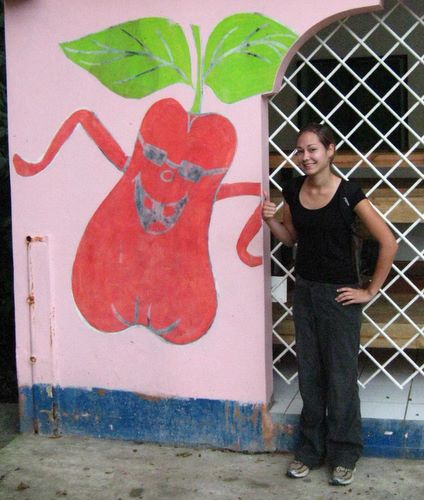
Andie next to the happy ackee fruit painted on the side of our cage
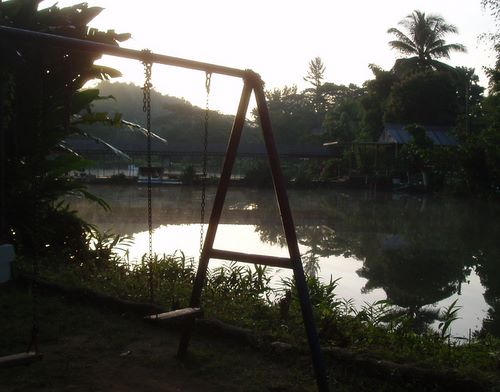
Abandoned amusements
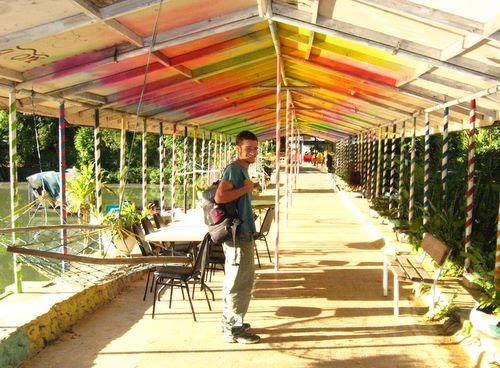
The colorful park entrance
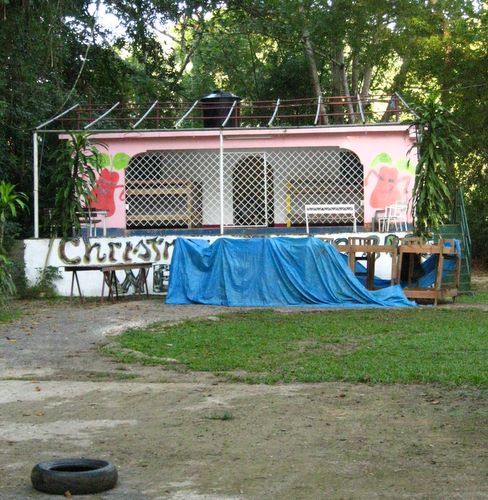
Our oh-so-humble abode
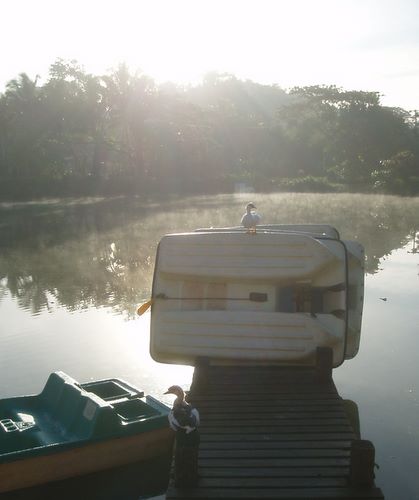
Ducks and paddle boats
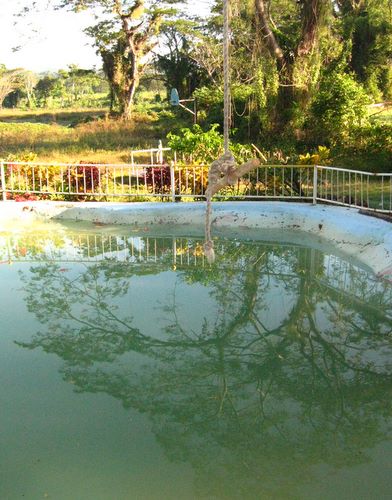
An inviting children's pool
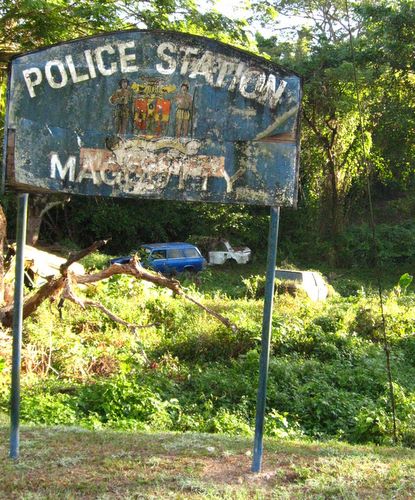
Never has there been a more accurate name for a town

Lovers Leap

Perhaps it was a taxi at one time

Long way down
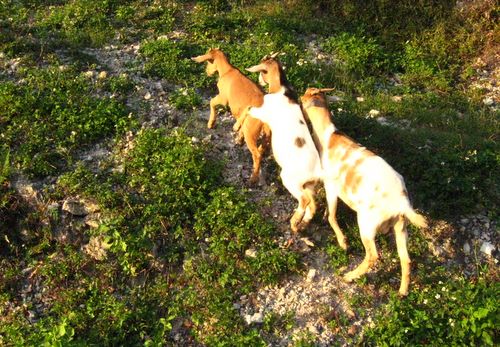
Everybody do the locomotion...
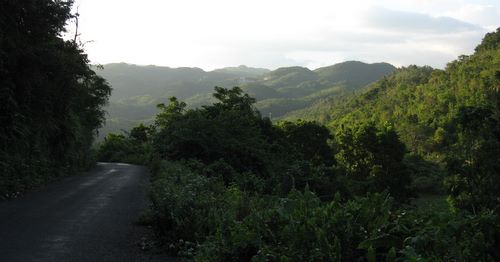
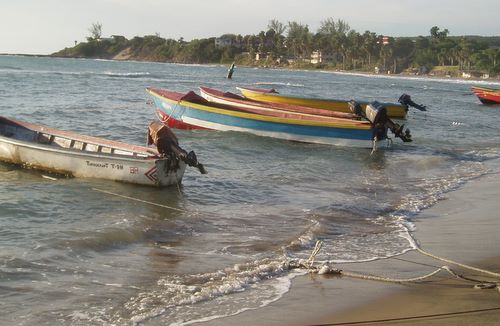
Fishing boats
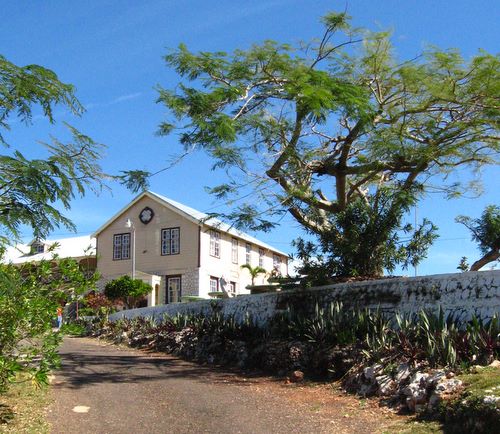
Hamilton College in Malvern
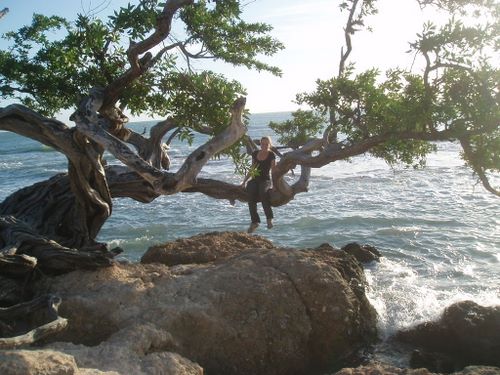
Andie in a tree
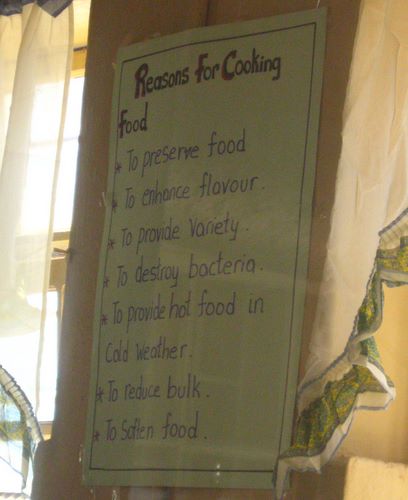
All fine reasons
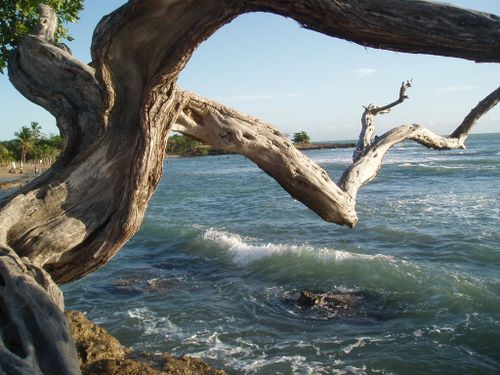
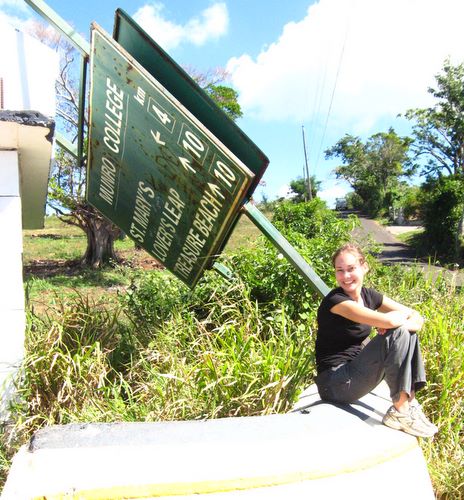


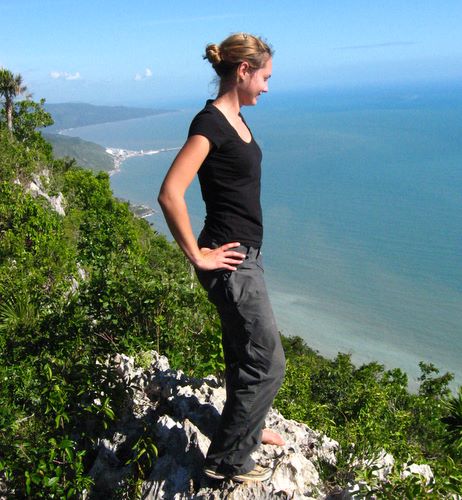
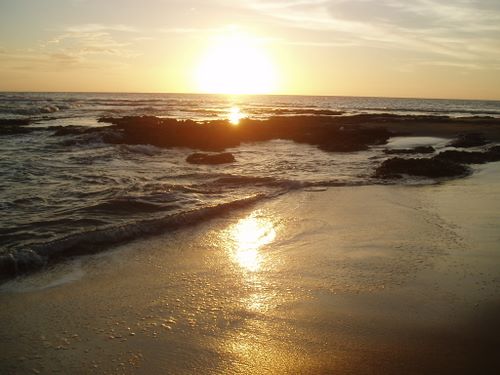
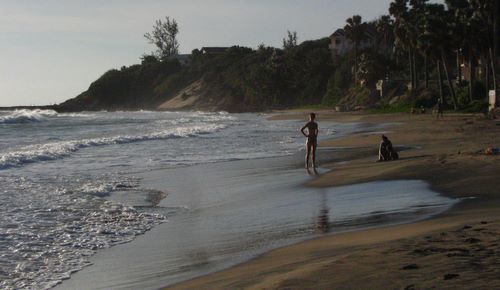


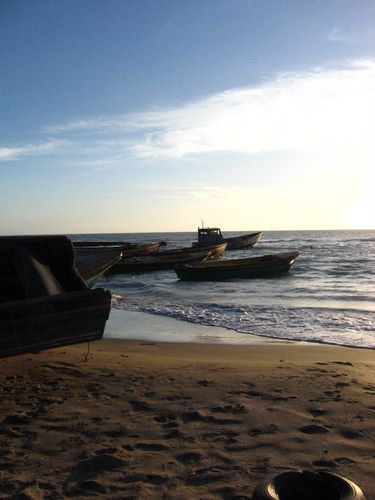
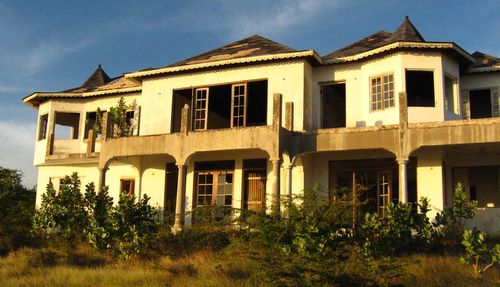
This abandoned mansion was once owned by a famous boxer and is now home to 12,000 wasps
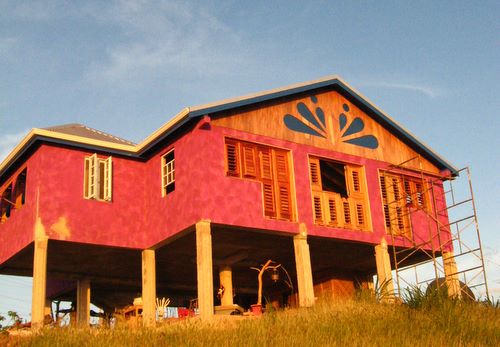
Our guidebook described Mandeville as "the most prosperous and pleasant town on the island"; the city was purported to have miles of picturesque roads twisting through the hills. When we arrived, downtown was filled with cops dressed in riot gear carrying machine guns. We went to a nearby patty shop to assess the situation; here a little girl came up to inform Andie that there was an enormous hole in the back of her pants. Fortunately, unlike myself, Andie was carrying an extra pair, and so she donned those jeans and we headed straight for the transport station. We grabbed a taxi to Christiana, which the guidebook touted as a relaxing mountain town complete with a forest reserve that had the country's largest cave system.
Christiana, too, turned out to be a bit rougher than expected and we couldn't track down a single person who knew the first thing about the reserve. We opted to make our way to the north coast where we would be assured of finding a reasonably priced guest house and grabbed the next taxi to Albert Town. We told the driver that we had found nothing in the way of cheap accommodation in the area and he immediately set about finding us a place to stay. The first two guesthouses we checked were full of out-of-towners for a wild New Years bash. Then one of the passengers suggested that we didn't actually need a guesthouse, but that any large house with a spare room would do. The driver called up one of his wealthier friends and set us up with a room in a half-completed two-story house in the scenic mountain village of Stettin which was only a mile out of Albert Town.
There wasn't much in the way of tourist attractions in Stettin, so we hiked up the main road, admired the views, chased some goats, watched a soccer game, and hit up an open grocery for fixings for our nightly meal. The clerk was disgusted by our recipe for rice and beans and encouraged us to take some saltfish or mackerel, but in the end we got away with only a packet of jerk seasoning to flavor our dish. We returned to the house about an hour before dusk and found Sister Act on one of the 100 cable channels on offer. The house was an interesting one - barely furnished except for an elaborate bar and a set of stripper poles. The owner and his roommates lived upstairs in a quintessential bachelor pad; the lone kitchen lacked any sort of utensils beyond a single pan and a pair of spoons; there was no can opener but one of the guys showed us how to open our beans with a machete.
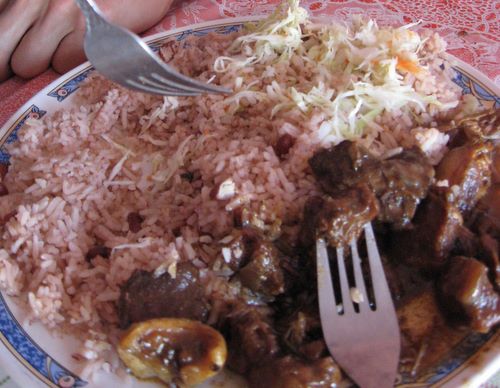
Maybe a curry or a stew... could be goat or chicken...
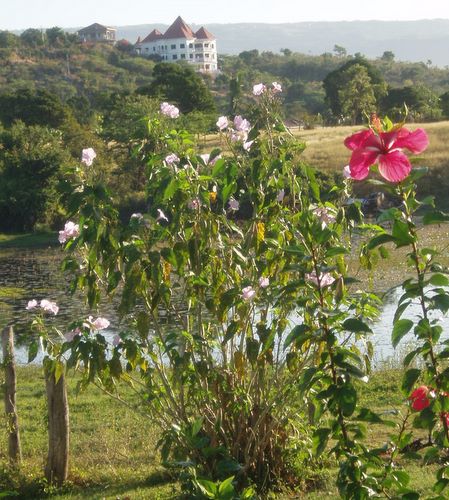
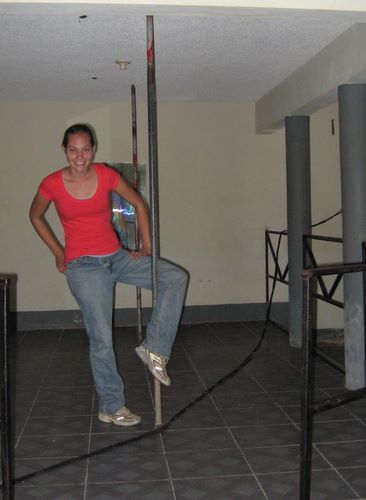
Andie showing off her skills

The last tourists who came to this town...

A pensive goat
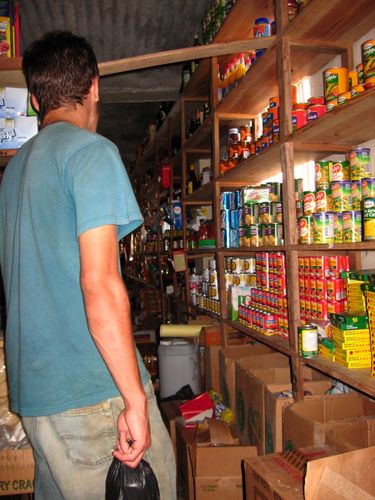
Shopping for the night's culinary adventure
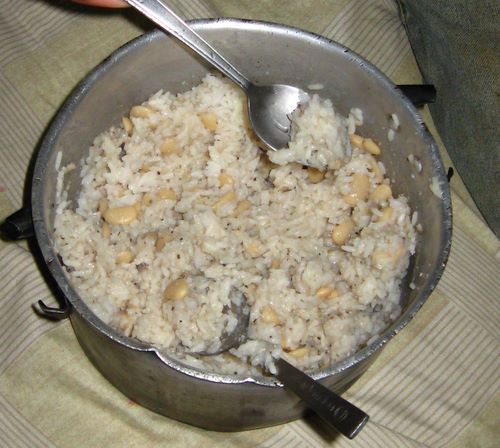
Tasted much better than this picture lets on
The town of Falmouth was apparently the epicenter of the slave trade and had a fine variety of crumbling, historic buildings. It also had a massive clothing market, and we considered picking up a few pieces to replace our rapidly deteriorating supply, but soon found that it was all of a fundamentally different shape than we would buy back home and would simply not accommodate our inferior posteriors.
We took a bus to the edge of Cockpit Country; along the route we saw many silly tourists sitting on bamboo rafts with bright orange life vests floating down the nearly still Martha Brae; a little further we began to spot a number of caves in the limestone walls that lined the road. Our bus dropped us at the town of Sherwood, and from there we had to walk the final 5km along a narrow road through the cockpits to Windsor. As we hiked, we began to notice a strange dearth of vehicular traffic (only 1 car and 2 bicycles in an hour's time) and began to wonder what sort of place awaited us at the end of this quiet jungle path.
What we found could hardly be labeled as a town at all; the road dead-ended at a little multi-colored shack next to a sign for Windsor Caves. A Rasta man named Dango (probably the mayor) had apparently been sitting in that shack and giving people tours of the caves for the past 37 years; he explained that there were about 10 people living in the town: 2 white people in a great house a few hundred meters to the left, the owner of a guesthouse a mile to the right and a smattering of small time farmers throughout the hills. We inquired as to why there were several fires blazing on the side of the road and he replied "I dunno, there just some little guy who likes to set fires, I dunno why he does it, but no harm done." He informed us that "The Last Resort" was the cheapest option for sleeping and we began the long hike out there.
The guesthouse was the headquarters of the Jamaican Caves Organization and had about 30 beds to accommodate the annual visit by the Belgian surveying group. When we arrived, the owner was the only one there, and he wanted nothing to do with the underground attractions that attracted most visitors to his lodge. Since I had known we would be hiking a long way through the bush, I had avoided taking any extra money out of the ATM and thus had to negotiate the price of the room to $20 from the standard rate of $30. This would not have been all that unreasonable in itself, but we had also failed to bring any food with us, so we requested that the owner include us in all of his cooking plans for $7 more. At this time, the water reservoirs feeding the pipes were empty so all of our cooking, drinking and bathing would be supplied by a number of buckets around the house that had been filled from a nearby spring (which some Belgian had tested for purity some time ago). Andie had some qualms about drinking unfiltered jungle water, but these were eventually quelled as she came to realize how difficult it would be to hike around for 2 days whilst drinking nothing at all. The owner was an excellent chef and prepared us a delicious dish of rice, fish, macaroni (from a Mac & Cheese box) and okra for lunch. We then set out to find the caves.
We stopped by Dango's shack to ask for directions but soon found that he would, under no circumstances, allow us to go to explore the caves without a guide (and more to the point, without paying him $15); this was a curious stance because he did not own the caves or have any sort of exclusive rights to it, and had probably explored fewer miles of cave passage than myself, but we gave into the extortion as we thought it wise not to make an enemy out of 10% of the town's population. So with a joint eternally dangling from his lips and a crank-powered flashlight in his hand, he led us along a well worn path through the first three chambers of the cave. These were quite impressive and probably had more large formations per unit area than I'd seen in any US cave. In the final chamber, Dango showed us that by shining a flashlight at a tiny hole in the ceiling, a flurry of a thousand bats could be coaxed out. After leaving the cave, he indicated the way to the larger entrance where we could purportedly see several million bats egress at dusk.
While we waited for nightfall, we walked down the road to visit the Americans and were slightly mangled by their giant, "friendly" dalmation. The woman explained to us that the cave we had just visited did, in fact, have its share of histoplasmosis, but we were likely in little danger because we were from the southeast and probably had immunity from hanging around chickens and such.
The directions we had received to the bat exodus point were at best, very rough. We were supposed to walk for a mile along a certain path, but after following the trail for nearly an hour, we still had seen no sign of the cave or bats. So we were left to follow the long, treacherous trail back in total darkness (though we did have headlamps). On the return trip, the jungle was illuminated by a thousand "peeny-wallies", a variant of fireflies, and had the feel of some fantastical fairy forest. The road back to our guesthouse was frequented by giant bullfrogs, but was fortunately free of any large carnivorous animals or poisonous snakes.
Dango had given us a bag of rice and a coconut to snack on for the evening since he had taken our entire food budget. The owner showed us how to grate a coconut and squeeze out the milk to make coconut rice. The night was peaceful; a cold front had moved in and brought with it one rain shower after another, and there was no sign of the bats that had frequented the rafters of our room on previous nights (a fact which we surmised from the large piles of guano that had covered our sheets when we arrived).

An eagle pulpet
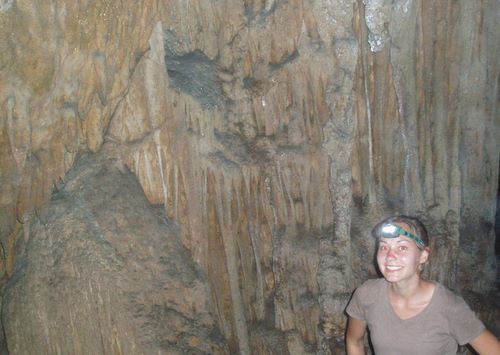

The availability of cheap machetes in this country is a tad disconcerting
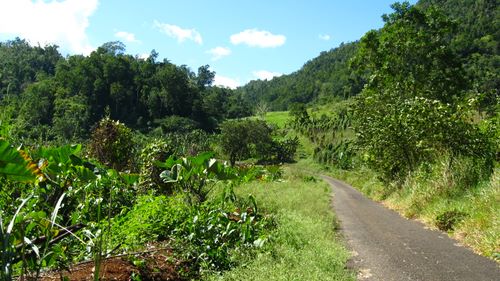
Road to Windsor
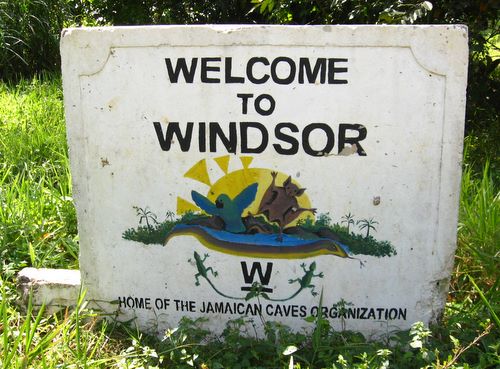
Here's the sign, now where's the town??

Main St., Windsor

Caving with the rasta man
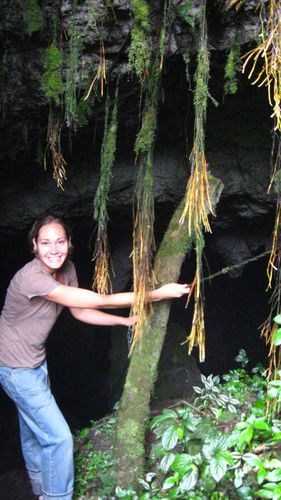
At the entrance to Windsor Cave
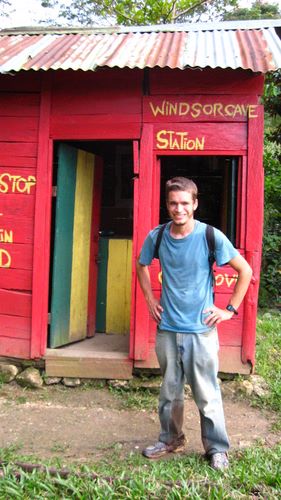
At the lair of the Cave Rasta
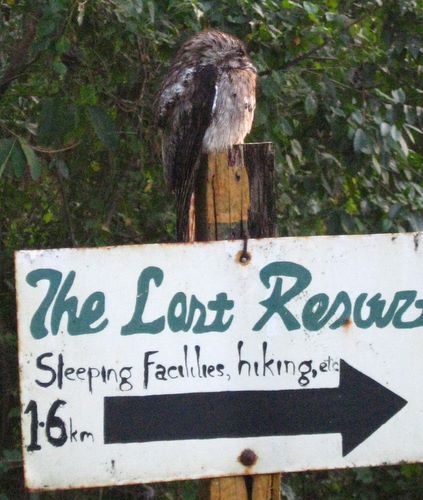
Some sort of bird
The road east of Port Maria had been completely decimated by a hurricane a few months earlier and a massive restoration project was underway; at the time of our travels, it was rather reminiscent of a Laotian highway, with more potholes than asphalt. One might imagine that this would encourage the drivers to go slower; it did not. We changed again at Annotto Bay and finally arrived in little "Portie" around 7.
The town's guesthouses were a hundred meters up a dark street from where the bus dropped us, and we hesitated for a minute and considered getting a taxi, but at that moment a mysterious man appeared and explained that he was a bamboo raft captain who worked for the very same guesthouse which we sought. This seemed a bit sketch, but following him would surely be easier and cheaper than the alternative, so we let him lead us to a retrofitted Victorian house where we found a room with an attached bath, hot water, antique furniture, and a view of the harbor for only $27. We then inquired about cheap restaurants and the same tout led us to a well-hidden place with tasty Jamaican fare; he then sat down to eat with us, possibly thinking that he could score a free meal, but in the end he only made off with a juice. We returned to the guesthouse to find that the water in our room had been shut off; according to the manager, this is something that was done citywide on odd days of the week as some sort of conservation effort.
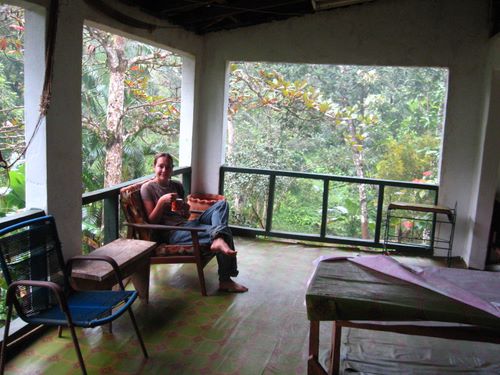
Our luxury rainforest accomodations

The headquarters of the Jamaican Caving Association
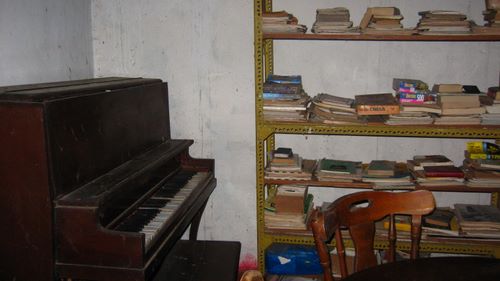
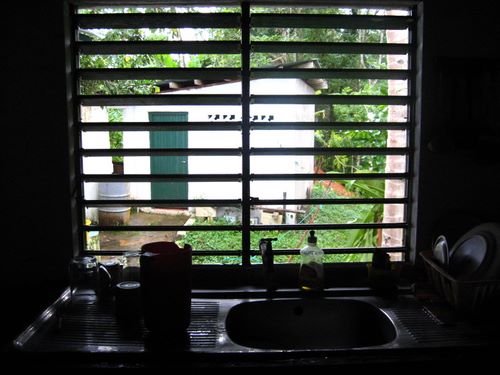
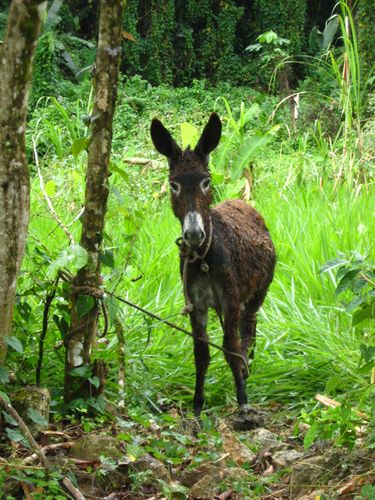
One very wet donkey

How to entertain yourself in a blackout.
On the opposite side of the harbor sits the crumbling remains of a Grecian-style mansion from the 30s which can be freely explored; here Andie discovered a homeless man living in one of the former broom closets.
We took a taxi east to the famed "Blue Lagoon" but found that it had been taken over by militant bamboo raft captains and there seemed to be no obvious way to explore it except by paying them large sums of money. We spotted an empty beach on the opposite side of the lagoon and looked into finding a way over there. Down the road, we found an abandoned resort and followed the driveway until we came upon a disused path which led deep into the jungle. It eventually ended on an epic cliff where we could safely watch the massive waves crash against the rocks, sometimes sending spray 40 meters into the air.
A random guy directed us to a vegetarian restaurant for lunch. He stayed and chatted with us for no apparent reason for the thirty minutes it took our dish to arrive. He claimed to be a doily salesman and aspiring musician, and he sang several reggae tunes that he had composed himself. He claimed his music would serve an important role in such meritorious goals as helping someone find spirituality and teaching a guy how to meet a lady. He had many philosophical sentiments to share with us; we suspect this had something to do with the liberal hits he was taking from his joint throughout our conversation.
We took another bus down to Long Bay. This was once the premier surfing beach of Jamaica, but like all the other stretches of sand in the area, had been reduced to nothing by the latest hurricane. The cold front that was apparently driving temperatures in Gainesville down to 10 or 20 degrees was whipping up some wicked surf in this neck of the woods, but no one, tourist or local, seemed willing to go out in the huge, tumultuous waves.
Around seven that night, all the lights in town went off; fortunately we were at the guesthouse and thus a safe distance from the bedlam which much have instantly ensued in the city. The guesthouse owner offered the explanation that "sometimes they turn off the lights." Perhaps this was another effort to reduce waste in "Jamaica's greenest parish," but Friday night seemed a poor choice for a blackout.
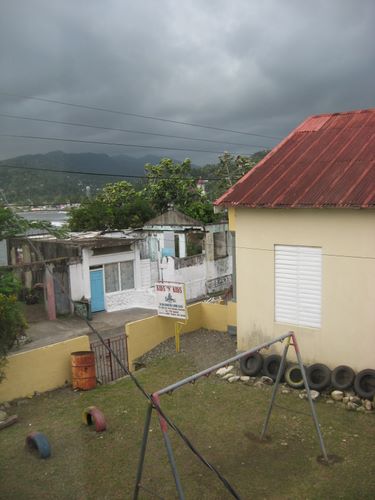
Our hotel's view of Port Antonio
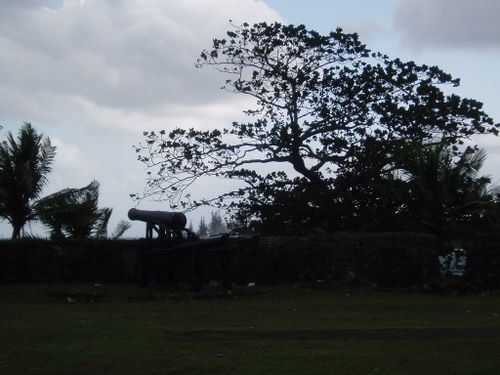
"A cannon for every child", that will always be the dream
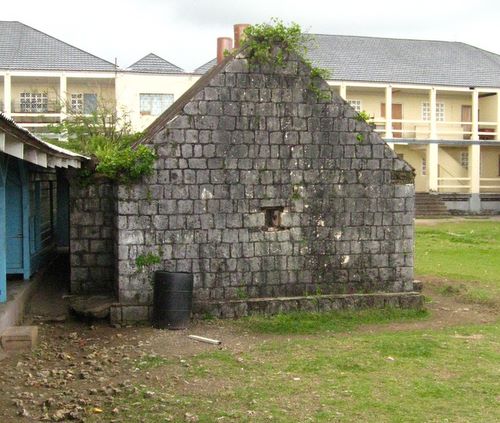
Barracks turned classroom
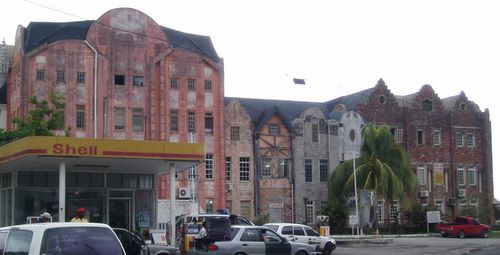
Built by a crazy German lady
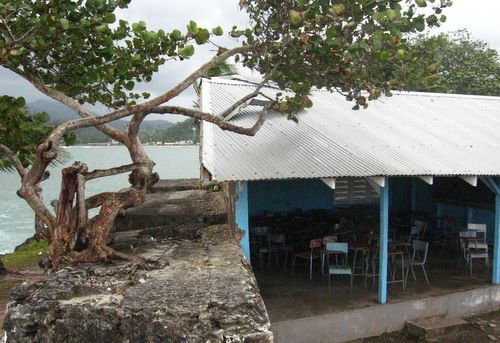
This school is safe from most types of artillery fire
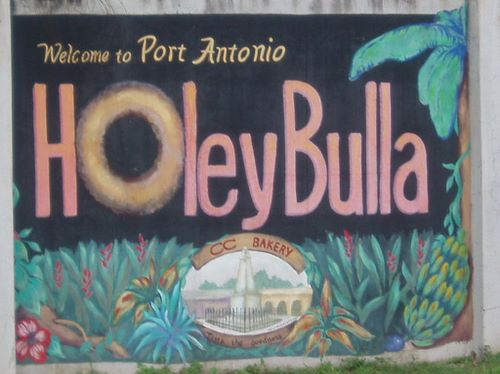
Jamaican for donut
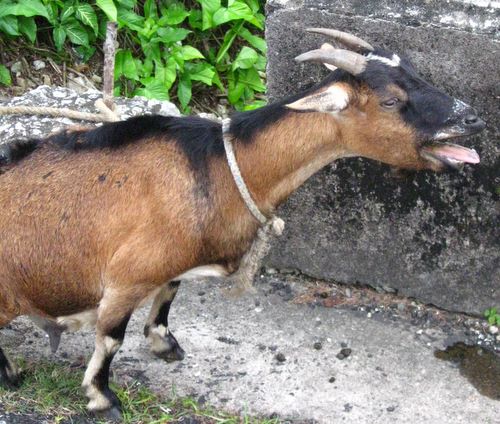
This goat seems to be laying an egg

Abandoned mansion
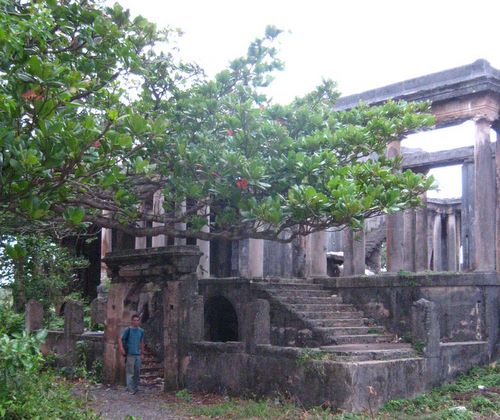

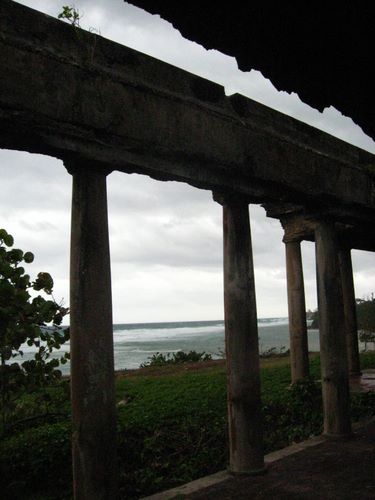
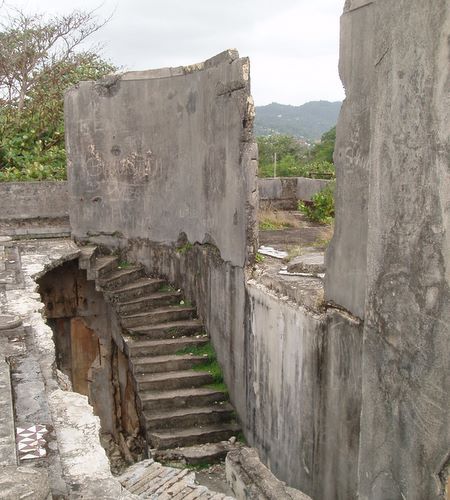
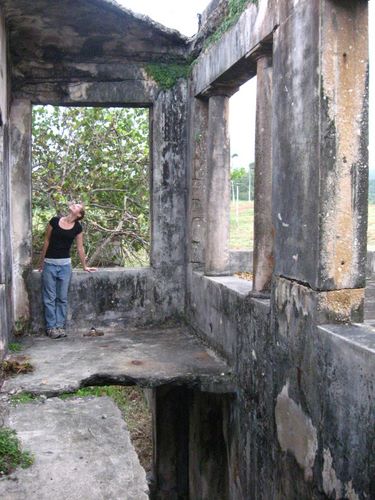
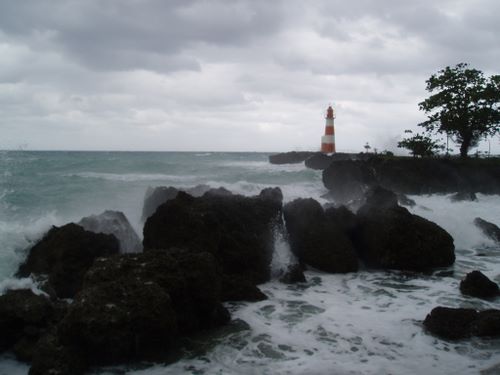
Folly lighthouse
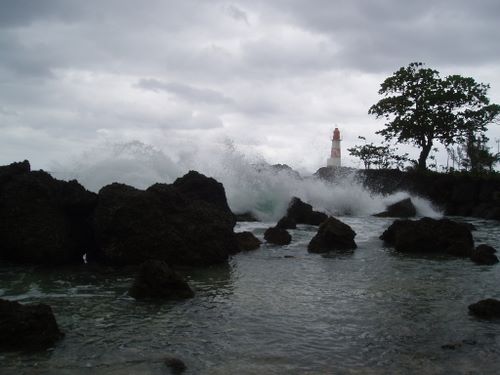
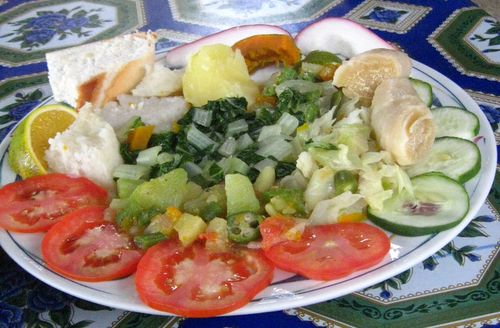
A Rastafarian smorgasboard
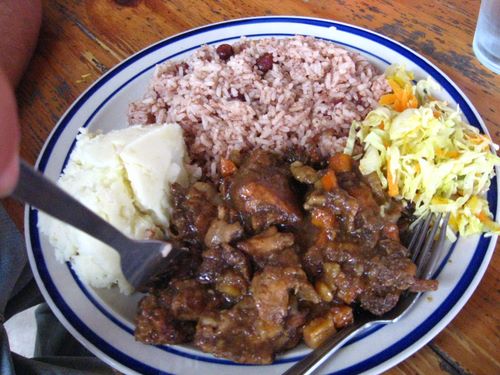
Vegetarian kick over - time for some meat!
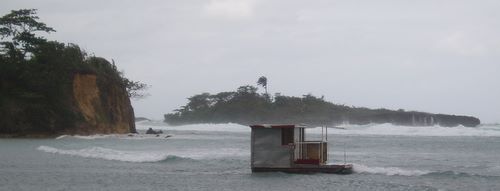
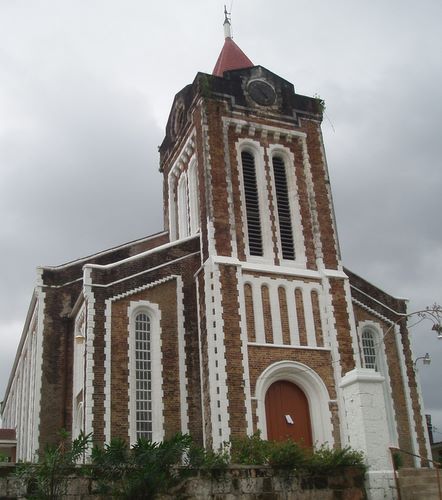
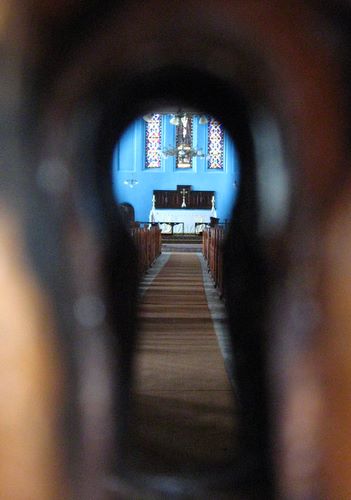
Through the keyhole
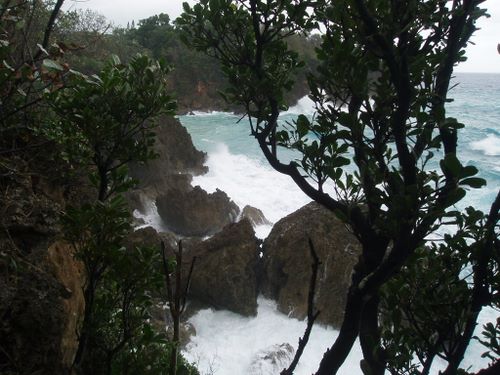
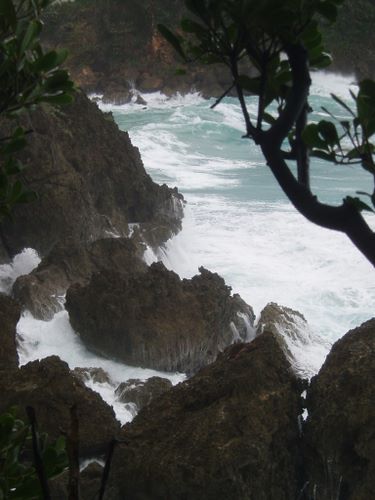
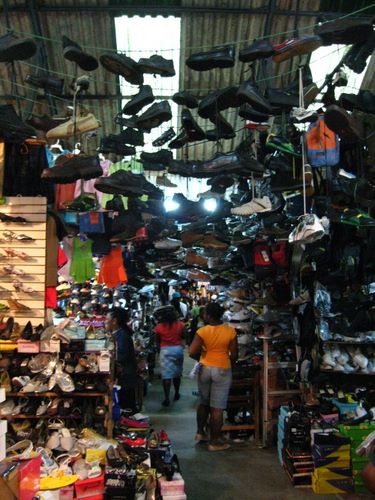
Sorely tempting, considering the state of my current shoes
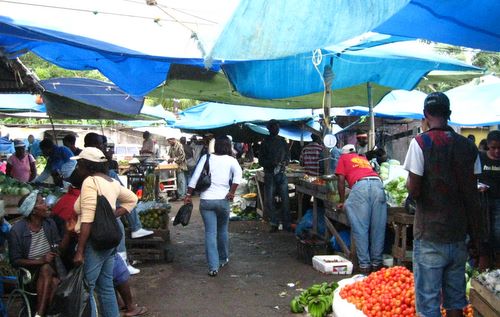
In the produce market
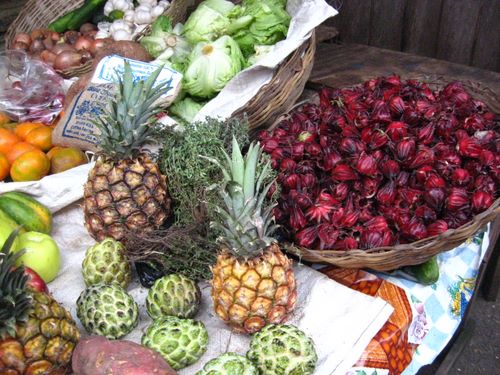
We visited a well-patrolled hassle-free zone named Turtle River Park; this is made up of well-manicured lawns, perfectly placed stone walkways, and picturesque springs; it represents a level of care that could never even be imagined to exist after visiting the rest of the island. Seven groundskeepers were stationed around the park just to make sure no blade of grass was knocked out of place. They doubled as security guards which I discovered when Andie convinced me to step over the two-foot fence into the turtle enclosure.
A little further down the town's main road, we discovered the Taj Mahal Shopping Center; this was a nest of enterprising Indians who had set up a vast array of duty-free shops all centered around a small, inexact replica of the palace. Still further down the street, we came across Island Village, which was a microcosm open only to international tourists that offered all the important elements of Jamaica - souvenir shops, coffee, and a beach - without forcing cruise passengers to venture out into the scary, unpasteurized country beyond. After exiting back through the airlock, we proceeded to a nearby pigeon zoo which had many kinds of pigeons and even chicks of some species (which were even uglier than the adult birds). At the same location, there was a small spring where nude bathing was strictly prohibited (with three signs in various phrasings and languages); we couldn't figure out why someone would be inclined to swim nude in the middle of the town, but we were thankful that the signs had seemingly prevented any would-be nudists from giving it a try. Back at the transport station, we grabbed the next bus to MoBay.
Once back in the city, we tracked own a nice guesthouse in the bustling streets of lower downtown, but finding it out of our price range, returned to our old haunt from the previous week. This time around we got a room immediately adjacent to the Seven Day Adventist Church which continued to sing and carry on well into the night.
We took a taxi down to the theatre and were dismayed to find that the cheapest ticket cost more than in Gainesville (there are 3 tiers: ours was seven bucks, for 10 we could have sat in the back 3 rows, and for 15 we could've worn a special hat to let people know we were special). The movie was preceded by a recording of the national anthem accompanied by inspiring and patriotic imagery; the whole theatre stood for this. There was then a series of six corny animations (and one video featuring Steve Martin) from the 80s that warned against talking, using cell phones, dropping popcorn, and of course, smoking ganja. The movie spontaneously stopped playing four different times for no apparent reason, but this did not dissuade the projectionist from interjecting a 15-minute intermission to make sure everyone was taking full advantage of the snack bar. The movie "I Am Legend" was a fine flick but I learned about 15 minutes in that Andie had a strong aversion to zombie movies. The Jamaicans got a kick out of the endearing references to their national musical hero.
After the zombies ate good ol' Willie, we went to a gas station next door to find a route taxi back to town. One of the people we talked to happened to be the driver of a 48-seat air-conditioned limo that was taking a pair of girls in stylish club dresses to an exclusive resort function. He offered to let us come along for the ride and be dropped off on the return trip to the city. So, for our last night in Jamaica, we gave up squishing into a Corolla with five random strangers and road back to our $20/night guesthouse in style.
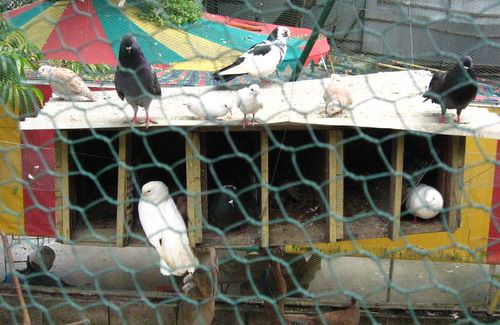
Pigeon zoo
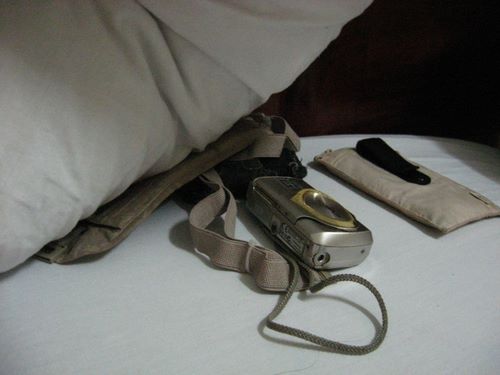
Does your hotel room have a gaping hole in the ceiling and an unlockable mystery door? Probably best to stuff all your worldly possessions under your pillow
We took a route taxi to the airport and checked in; the security girl selected my bag to check and instantly regretted her decision as all of my clothes were smelly and slightly wet. Later at the security checkpoint, the guard covered her nose and cowered away from our stinking shoes that we were made to place on the belt.
Next, we went to the currency exchange office. Correct change is not a common phenomenon in this country and this was no exception; the employee simply could not come up with 8 US dollars to give me, so I used some spare change to bargain for a $10 bill (yes, even the currency exchange bargains).
Once in the international terminal, Andie went in a perfume shop to get some samples to stuff in our shoes in a futile attempt to save our fellow passengers from whatever evil was lurking in our soles. We had picked up a 2lb loaf of bread and a block of cheese (somehow the Jamaicans invented a non-perishable cheese) the night before and spent the next few hours snacking on that and reading through the motley collection of books we had brought along. About half an hour before our scheduled departure, Andie happened to check the departure board and noticed that our boarding time had been pushed back from 1:10 to 4:50. As this information filtered through the masses, wave after wave of disgruntled passengers went to the airline representatives (who were trying their best to make themselves scarce) to demand some form of reimbursement. Some managed a night's hotel stay, transport from the airport, and a $200 travel voucher, but most, ourselves included, got nothing more than a $7 lunch voucher that only worked at about a third of the airports vendors and was barely sufficient to buy a hotdog. The departure time was later pushed back to 6:35, and when the 4:50 flight to the same location left on schedule, the mob was whipped into a frenzy. With a hundred demands being shouted at once, there seemed no chance of securing a taxi ride to our car in West Palm (which would now be necessary since we would miss the final train of the night). Shortly before departure, we were told that everyone on the flight would receive a free roundtrip ticket to anywhere, anytime in the next year. In an instant, all the frustration of the previous 7 hours vanished and any misgivings about standing at a sketchy south Florida bus station at 10PM suddenly seemed kind of trivial. Visions of Macchu Picchu danced in our heads.
After a quick flight we arrived in South Florida and headed for the service desk. We soon found that the line for the 2 available representatives stretched across the entire ticketing hall. We went outside to find a bus but found that, since it was Sunday, all services had been stopped for the night. So we returned to wait in the line. After around an hour of sitting in the exact same spot, Andie went and sweet-talked the couple at the front of the line, took their place, and got the taxi voucher we needed.
At the taxi stop, we soon discovered that the dispatcher was completely out of his mind. When a driver asked a woman where she wanted to go, he dismissed him and called for the next one; somehow this second guy made the same mistake and was dismissed in the same way. After the fourth cab had pulled up, we grabbed our voucher from the madman, who was engaged in a heated argument with the first three drivers, and jumped in the final car.
We arrived at West Palm around 11 and made it back to Sarasota by 3am. By noon we were back in Gainesville and Andie made it back to Tally in time to avoid being disqualified from attending any of her classes (FSU has a bizarre policy where it actually requires you to go to class on the first day!).
Jamaica was an amazingly beautiful country with super-friendly people, excellent food, fast transport, and an endless array of potential (but not actual infrastructure) for outdoor pursuits. Since essentially the entire island is made of karst, the possibilities for caving are virtually endless. And with a plethora of strange abandoned buildings, urban spelunkers can explore to their heart's content. Unsigned goat paths and hunting trails venture into dense jungle and it is easy to feel as if you are the first to forge a trail through an unexplored land. At least for the backpacker, the island in no way resembles the nightmare everyone seems to believe it is, and I recommend it to everyone who is willing to bring a sturdy pair of jeans, a sense of humor, and just a smidgen of common sense.
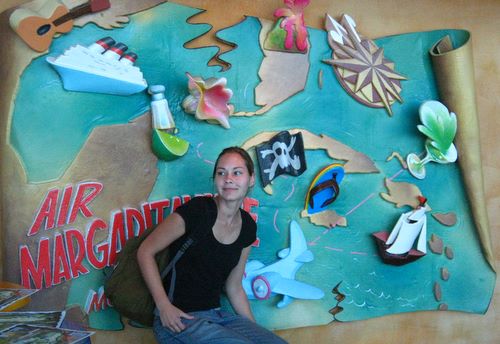
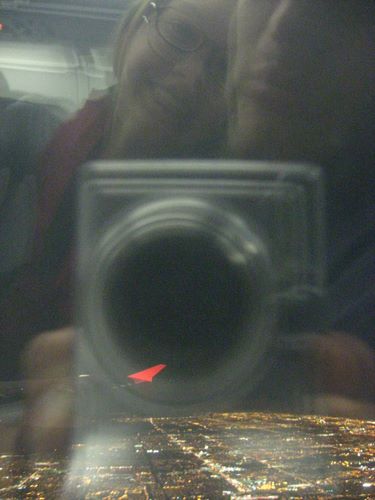
Bienvenido a Miami!